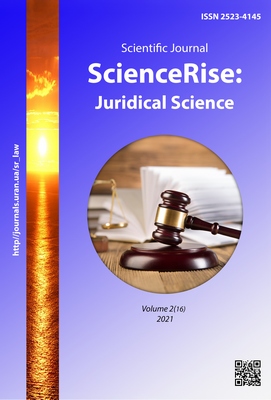Internet fraud: technologies of performance, ways of counteraction and prevention
DOI:
https://doi.org/10.15587/2523-4153.2021.235769Keywords:
prevention, means, Internet, false information, counteraction, investigation, method, technology, fraudAbstract
The article proves that the separation of technologies for committing fraud on the Internet allows you to determine the causal complexes. As a result, it is possible to effectively influence the prevention and counteraction of the corresponding type of crime. The author concludes that it is necessary to introduce into the practice of law enforcement and other government agencies effective tools for preventing and combating Internet fraud. He sees such a tool as outreach activities and modes of action that will block the determinants of criminal behavior in cyberspace. In order to concretize the specified means of prevention, it also deepens the theoretical basis regarding the system for preventing Internet fraud. So, the author comes to the conclusion that counteraction is a system of measures and methods of activity not only of law enforcement agencies, but also of other state and non-state bodies, while among these measures there are measures to prevent certain types of crimes.
The article indicates that in the process of implementing a certain type of cybercrimes by criminals, they talk about the technologies of criminal activity as complexes of interrelated crimes, united by a single criminal purpose. For the commission of Internet fraud in the technology of criminal activity, there are typically ways of committing crimes in the use of computers, systems and computer networks and telecommunication networks (provided for in Section XVI of the Criminal Code of Ukraine) and Art. 200 of the Criminal Code of Ukraine. As a result of the analysis of the materials of the forensic practice of investigating fraud on the Internet, two main technologies have been identified: 1) the seizure of funds using phishing sites (the methods of reporting false information from the victim and its content have been updated) 2) the seizure of funds using a bank payment card and / or ATM (the variability of the method of manipulating information has been updated)
References
- U 2020 rotsi do kiberpolitsii nadiishlo ponad 30 tysiach zvernen shchodo shakhraistva v Interneti (2021). Available at: https://cyberpolice.gov.ua/news/u--roczi-do-kiberpolicziyi-nadijshlo-ponad--tysyach-zvernen-shhodo-shaxrajstva-v-interneti-8412/
- Pro zapobihannia ta protydiiu lehalizatsii (vidmyvanniu) dokhodiv, oderzhanykh zlochynnym shliakhom, finansuvanniu teroryzmu ta finansuvanniu rozpovsiudzhennia zbroi masovoho znyshchennia (2019). Zakon Ukrainy No. 361-IX. 06.12.2019. Available at: https://zakon.rada.gov.ua/laws/show/361-20#Text
- Pro zatverdzhennia Polozhennia pro Departament kiberpolitsii NP Ukrainy (2015). Nakaz Natsionalnoi politsii Ukrainy No. 85. 10.11.2015. Available at: https://cyberpolice.gov.ua/normatyvno-pravovi-akty-yaki-rehlamentuiut-diialnist-politseiskoi-komisii/
- Orlov, P. I., Volobuiev, A. F., Osyka, I. M. ta in. (2004). Protydiia ekonomichnii zlochynnosti. Kharkiv: Nats. un-t vnutr. sprav, 568.
- Butuzov, V. M., Pavlovskyi, V. D., Skalozub, L. P. ta in.; Romaniuk, B. V., Skulysh, Ye. D. (Ed.) (2011). Orhanizatsiino-pravovi ta taktychni osnovy protydii zlochynnosti u sferi vysokykh informatsiinykh tekhnolohii. Kyiv, 404.
- Kosenkova, N. A., Sirodan, T. O. (2014). Protydiia kiberzlochynnosti. Kyiv, 48.
- Samoilenko, O. A.; Volobuiev, A. F. (Ed.) (2020). Osnovy metodyky rozsliduvannia zlochyniv, vchynenykh u kiberprostori. Odessa: TES, 372.
- Wi-Fi-zlodii: sposoby zakhystu. Nezalezhna asotsiatsiia bankiv Ukrainy. Available at: http://anticyber.com.ua/article_detail.php?language=ua&id=108
- Samoilov, S. V. (2014). Rozsliduvannia shakhraistv, uchynenykh iz vykorystanniam merezhi Internet. Donetsk, 226.
- Samoilenko, O. A. (2018). Kharakterystyka tekhnolohii vchynennia zlochyniv u kiberprostori. Sudova ta slidcha praktyka v Ukraini, 7, 64–71.
- Sidel, R. (2015). Theft of debit card data from ATMs soars. The Wall Street Journal. Available at: https://www.wsj.com/articles/theft-of-debit-card-data-from-atms-soars-1432078912
- HSBC UK pilot of new, industry-first technology reduces ATM “cash-trapping” fraud losses by 50 % (2015). HSBC Holdings plc. Available at: https://www.atmia.com/news/hsbc-uk-pilot-of-new-industry-first-technology-reduces-atm-cash-trapping-fraud-losses-by-50/9188/
Downloads
Published
How to Cite
Issue
Section
License
Copyright (c) 2021 Olena Samoilenko, Kateryna Titunina

This work is licensed under a Creative Commons Attribution 4.0 International License.
Our journal abides by the Creative Commons CC BY copyright rights and permissions for open access journals.
Authors, who are published in this journal, agree to the following conditions:
1. The authors reserve the right to authorship of the work and pass the first publication right of this work to the journal under the terms of a Creative Commons CC BY, which allows others to freely distribute the published research with the obligatory reference to the authors of the original work and the first publication of the work in this journal.
2. The authors have the right to conclude separate supplement agreements that relate to non-exclusive work distribution in the form in which it has been published by the journal (for example, to upload the work to the online storage of the journal or publish it as part of a monograph), provided that the reference to the first publication of the work in this journal is included.









